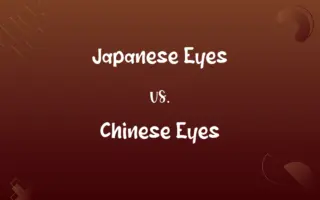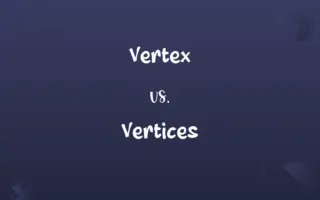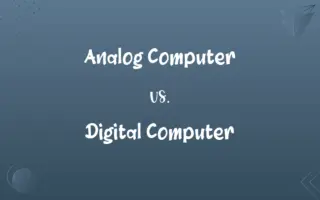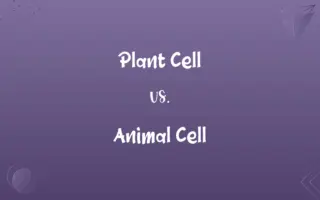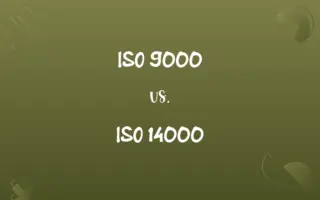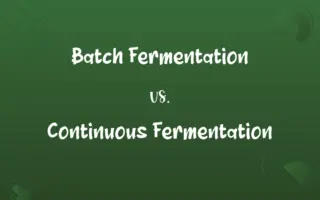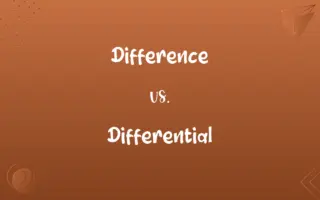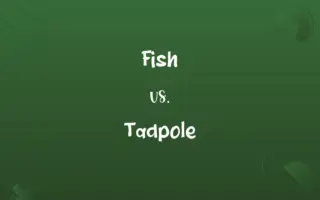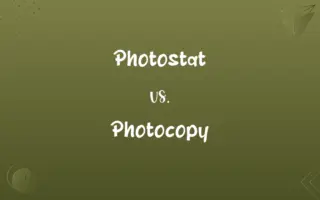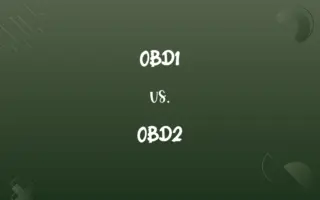Gross Primary Productivity vs. Net Primary Productivity: Know the Difference

By Shumaila Saeed || Updated on December 25, 2023
Gross Primary Productivity (GPP) is the total rate of photosynthesis in an ecosystem, while Net Primary Productivity (NPP) is the rate of energy stored as biomass after accounting for energy used in respiration.

Key Differences
Gross Primary Productivity (GPP) refers to the total amount of organic material produced through photosynthesis by primary producers like plants in an ecosystem. Net Primary Productivity (NPP), on the other hand, is the amount of organic material remaining after these primary producers use some of it for their own energy needs, known as respiration.
Shumaila Saeed
Dec 23, 2023
GPP represents the total energy captured by autotrophs in an ecosystem, which is a measure of the ecosystem’s capacity to convert carbon dioxide into organic material. NPP is essentially GPP minus the energy expended by the primary producers during respiration, providing a more accurate representation of the energy available for the next trophic levels.
Shumaila Saeed
Dec 23, 2023
GPP is critical in assessing the overall productivity and health of an ecosystem, as it indicates the maximum potential photosynthesis rate. NPP is crucial for understanding how much energy is available for consumption by herbivores and decomposers in the ecosystem, reflecting the actual energy flow.
Shumaila Saeed
Dec 23, 2023
In calculating GPP, one measures the total rate of photosynthesis, including the energy used for growth, reproduction, and maintenance of organisms. When calculating NPP, the focus is on the balance of energy stored after subtracting the energy used for respiration, showing the net growth of the ecosystem.
Shumaila Saeed
Dec 23, 2023
High GPP indicates a highly productive ecosystem, but it does not necessarily mean high availability of energy for other organisms. A high NPP, however, directly indicates that a significant amount of energy is being transferred to support a diverse array of life forms in the ecosystem.
Shumaila Saeed
Dec 23, 2023
ADVERTISEMENT
Comparison Chart
Definition
Total rate of photosynthesis.
Photosynthesis rate minus energy used in respiration.
Shumaila Saeed
Dec 23, 2023
Purpose
Measures total energy capture by autotrophs.
Indicates available energy for higher trophic levels.
Shumaila Saeed
Dec 23, 2023
Energy Consideration
Includes all energy produced.
Considers energy available after respiration.
Shumaila Saeed
Dec 23, 2023
Ecosystem Assessment
Indicates maximum photosynthetic capacity.
Reflects net ecosystem growth and health.
Shumaila Saeed
Dec 23, 2023
Implication
High GPP doesn't imply high energy availability for other organisms.
High NPP means more energy for supporting diverse life.
Shumaila Saeed
Dec 23, 2023
ADVERTISEMENT
Gross Primary Productivity and Net Primary Productivity Definitions
Gross Primary Productivity
The total rate of energy capture via photosynthesis in an ecosystem.
The Amazon rainforest exhibits a high Gross Primary Productivity due to its dense vegetation.
Shumaila Saeed
Dec 04, 2023
Net Primary Productivity
The rate of energy stored as biomass in an ecosystem after accounting for respiration.
The Net Primary Productivity of a forest is a crucial indicator of its capacity to support wildlife.
Shumaila Saeed
Dec 04, 2023
Gross Primary Productivity
Represents the maximum potential of an ecosystem to produce organic material.
Scientists measure Gross Primary Productivity to understand the potential impact of climate change on forests.
Shumaila Saeed
Dec 04, 2023
Net Primary Productivity
Determines the energy available for growth and reproduction in plants.
Shumaila Saeed
Dec 04, 2023
Gross Primary Productivity
Indicates the overall photosynthetic activity of an ecosystem.
Grasslands have a significant Gross Primary Productivity, especially in the growing season.
Shumaila Saeed
Dec 04, 2023
ADVERTISEMENT
Net Primary Productivity
Reflects the actual amount of organic material available for other trophic levels.
Coral reefs often have a high Net Primary Productivity, supporting a diverse range of marine life.
Shumaila Saeed
Dec 04, 2023
Gross Primary Productivity
The total amount of carbon fixed by plants in a given area and time.
In a healthy wetland, the Gross Primary Productivity can be extremely high due to abundant plant life.
Shumaila Saeed
Dec 04, 2023
Net Primary Productivity
The balance between the energy plants produce and the energy they consume.
In agricultural lands, enhancing Net Primary Productivity can lead to higher crop yields.
Shumaila Saeed
Dec 04, 2023
Gross Primary Productivity
A measure of the rate at which plants and algae convert sunlight and CO2 into biomass.
Aquatic ecosystems often have varied Gross Primary Productivity rates depending on sunlight and nutrient availability.
Shumaila Saeed
Dec 04, 2023
Net Primary Productivity
A measure of the net increase in plant biomass.
Savannas have a lower Net Primary Productivity during dry seasons due to limited plant growth.
Shumaila Saeed
Dec 04, 2023
Repeatedly Asked Queries
Why is GPP important in ecosystems?
GPP is a crucial measure of the potential energy available to support higher trophic levels in ecosystems.
Shumaila Saeed
Dec 23, 2023
What is Gross Primary Productivity (GPP)?
GPP is the total rate at which plants and other primary producers convert solar energy into chemical energy through photosynthesis.
Shumaila Saeed
Dec 23, 2023
How is GPP expressed?
GPP is typically expressed in units of energy per unit area per unit time, such as grams of carbon per square meter per year (g C/m²/yr).
Shumaila Saeed
Dec 23, 2023
What factors influence GPP?
Factors like sunlight, temperature, water availability, and the presence of chlorophyll-containing plants affect GPP.
Shumaila Saeed
Dec 23, 2023
Is GPP a net value?
No, GPP is a gross value that does not account for the energy used by plants in respiration.
Shumaila Saeed
Dec 23, 2023
What does GPP measure?
GPP measures the total energy captured by primary producers before any energy is used for their own metabolic needs.
Shumaila Saeed
Dec 23, 2023
What units are used to express NPP?
NPP is typically expressed in units like grams of carbon per square meter per year (g C/m²/yr).
Shumaila Saeed
Dec 23, 2023
Can GPP vary seasonally?
Yes, GPP often varies with seasons, peaking when environmental conditions are favorable for photosynthesis.
Shumaila Saeed
Dec 23, 2023
What is Net Primary Productivity (NPP)?
NPP is the rate at which plants accumulate and store energy as organic matter after subtracting energy lost due to respiration.
Shumaila Saeed
Dec 23, 2023
Can NPP be negative?
Yes, in some cases, NPP can be negative when respiration exceeds GPP, indicating a loss of energy.
Shumaila Saeed
Dec 23, 2023
How can GPP be measured?
GPP can be estimated using techniques like eddy covariance, remote sensing, and chamber-based measurements.
Shumaila Saeed
Dec 23, 2023
What is the ecological significance of NPP?
NPP determines the amount of energy available for herbivores and, consequently, the entire food web in an ecosystem.
Shumaila Saeed
Dec 23, 2023
What is the relationship between GPP and NPP?
NPP is the amount of energy left after deducting plant respiration from GPP.
Shumaila Saeed
Dec 23, 2023
How can NPP be measured or estimated?
NPP can be estimated using various methods, including satellite remote sensing, carbon cycle models, and field measurements.
Shumaila Saeed
Dec 23, 2023
What is the role of GPP in the carbon cycle?
GPP represents the input of carbon into the terrestrial carbon cycle through photosynthesis.
Shumaila Saeed
Dec 23, 2023
How does NPP contribute to carbon sequestration?
NPP plays a critical role in capturing and storing carbon dioxide from the atmosphere, helping to mitigate climate change.
Shumaila Saeed
Dec 23, 2023
How is NPP calculated?
NPP is calculated by subtracting GPP (gross primary productivity) from the energy used by plants in respiration.
Shumaila Saeed
Dec 23, 2023
Why is NPP important in ecology?
NPP quantifies the energy available to support herbivores and other consumers in an ecosystem.
Shumaila Saeed
Dec 23, 2023
What affects NPP in ecosystems?
Factors like climate, nutrient availability, and plant species composition influence NPP.
Shumaila Saeed
Dec 23, 2023
How does NPP vary globally?
NPP varies across different ecosystems, with higher values in tropical rainforests and lower values in deserts.
Shumaila Saeed
Dec 23, 2023
Share this page
Link for your blog / website
HTML
Link to share via messenger
About Author
Written by
Shumaila SaeedShumaila Saeed, an expert content creator with 6 years of experience, specializes in distilling complex topics into easily digestible comparisons, shining a light on the nuances that both inform and educate readers with clarity and accuracy.







